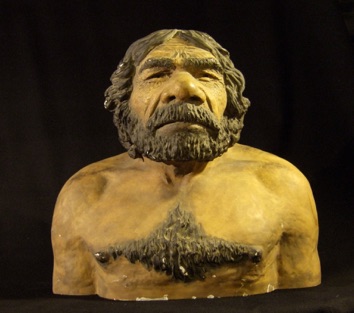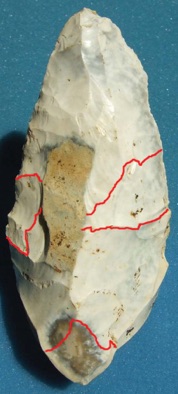A Neanderthal Insulation & Extinction Hypothesis


A typical reconstruction of Neanderthal skin and soft tissues. Is it correct?
In 2008, the first of two papers appeared presenting evidence for a new reconstruction of one of the two races or even sub-species of Neanderthals - the more robustly built northern lineage as opposed to the gracile population in the temperate Middle East - based on biological and behavioral adaptations which might account both for their endurance of glacial conditions and eventual extinction as a recognizable form when faced with competition. The hypothesis outlined in the papers turns out to be the only one to have predicted and explained why modern lineages from outside sub-Saharan Africa have a small admixture of Neanderthal genes (between 1 and 4%, as it turns out, from the latest analysis of the Neanderthal genome) from contact with gracile Levantine Neanderthals, but have almost none from the bulk of the Neanderthal population, which lived across a large swath of northern Eurasia and had thermoregulatory adaptations which set them apart.
The first article, “Are Neanderthal Portraits Wrong? Neanderthal adaptations to cold and their impact on Palaeolithic populations”, which appeared after peer review in Rock Art Research (2008, Vol. 25, No. 1: 101-116), outlines the fundamentals of the Neanderthal Insulation Hypothesis.
The prevailing explanation for the robustness of northern Eurasian Neanderthal bones is that they were adapted to withstand the mechanical stress of enormously strong muscles – not that their robustness was an adaptation to the combined stress of somewhat less powerful muscles and the weight of an insulating layer of fat that grew thick enough in the autumn to protect such “classic” Neanderthals against intense cold. The distinction is crucial, because its ramifications include new explanations for the Neanderthals’
- extinction, and
- apparent failure to hybridize to a significant extent with more gracile early Moderns outside the Middle East.
Surprisingly, the hyper-athletic paradigm for all Neanderthals has been universally accepted even though it is metabolically impossible that Neanderthals from colder areas could have survived extended periods at minus 40˚C - not counting wind chill - by merely exercising, no matter how muscular they were, if they had not had either fitted clothing or biological insulators. Yet such frigid conditions exist even today, when we are in a period of global warming - not an ice age - in many places where Neanderthals once lived without leaving any of the tools associated with the production of weather-tight clothing. How could they and their immediate ancestors have possibly survived several ice ages? Pollen from alpine plants at lowland Neanderthal sites as far south as France and deep accumulations of a wind-blown soil called loess prove that it was even colder and windier - especially during glacial maximums - from the Dordogne to Susiluola (Wolf) Cave in Lappfjärd, Finland, where Neanderthals lived over 74,000 years ago. Despite this, the absence of tools associated with the lacing of hides from all but a few of the last Neanderthal sites suggests that weather-tight, seamed clothing was not made by early Neanderthals - and perhaps even any Neanderthals, until they had almost become extinct.
The first article argues that technological, genetic, geographic and osteological clues - the last of which involves shoulder-to-pelvis ratios and features of the femur - all indicate that classic Neanderthals survived such conditions by literally growing a well-distributed layer of subcutaneous insulatory fat each summer and fall to survive the winter, and that they were somewhat less muscular than current reconstructions.
This has radical implications in terms of Neanderthal nutrition, which appears to have consisted of more carbohydrates than previously imagined, and the behavior and tools required to obtain starchy foods. The article’s companion piece, “Afterthoughts about the Neanderthal insulation hypothesis” (AURA Newsletter, 2008, Vol. 25, No. 2), adds to the hypothesis by introducing evidence that Neanderthals dug up and processed underground storage organs such as cattail rhizomes during the fall and winter, when these organs are most nutritious. This includes the first observation that lanceolate bifaces in the Yonne, which are concentrated around clay bogs, often bear so much soil sheen from digging in silica-rich soils that they could almost be mistaken for Neolithic hoes, suggesting that they were used as trowels.

The soil sheen on this Middle Paleolithic (MAT) biface from the edge of a clay depression on a plateau at Villecien in the Yonne is most intense between the tip and first line and again below the line around the spur at the base. Such soil sheen on Mousterian lanceolate bifaces found around bogs suggests that they were used for digging up and processing cattail (Typha latifolia) rhizomes. Other plants with underground storage organs that occurred throughout the Neanderthal range included Sagittaria sagittifolia (arrowhead), Polygonum bistorta (mountain bistort), Pastinaca sativa (wild parsnip), and Arctium lappa (greater burdock).
Another corollary of the hypothesis is that cold-weather Neanderthals had sexual cues that were quite different from those of modern humans, because such cues are necessary to preserve a lineage’s specific thermoregulatory adaptations from generation to generation. One of the features that our highly visual cues maintain is body baldness, which we need as part of our whole-body cooling system that involves sweating. The more robust Neanderthals outside the Levant apparently shed heat mainly through their radiative noses, which were much wider and more prominent than any modern human’s. This would have allowed them to have both subcutaneous and epidermal biological insulators - fur - which would have been preserved down Neanderthal generations by radically different sexual signals from ours. The visual cues that made European Neanderthals attractive to each other would have been so different from those of Moderns - from head to toe - that they are probably enough to explain:
-
1)the low admixture of Neanderthal traits in early modern European fossils, and
-
2)the absence of genetic evidence of hybridization between “Moderns” and Neanderthals, except during an initial encounter with a gracile race of Neanderthals who were adapted to the temperate climate of the Middle East.
Finally, the hypothesis goes a long way towards explaining the extinction of cold-weather Neanderthals when faced with intruders whose bodies did not invest themselves annually in growing protective tissues such as hair, fat and specialized vascular systems. Although both Neanderthals and the intruding early Moderns used similar stone tools in some places, only a few Neanderthal sites where tools made of organic materials were preserved include the additional bone tools needed for sewing hides into fitted (instead of just draped) clothing while all of the intruders’ sites with such taphonomic conditions contain them. Poignantly, the handful of Neanderthal sites, like Arcy-sur-Cure, with such evidence are just local anomalies, near the end of the Neanderthal reign. The early Modern intruders would have been able to tighten, loosen or even shed their insulation from moment to moment, giving them enormous flexibility to exploit environments (and the microenvironments within highly insulated structures) whose temperatures varied widely, allowing them to move like circumpolar peoples today from torrid winter houses to blizzards and back. Biologically insulated Neanderthals, on the other hand, would not have been able to instantly shed the fat or fur they had physically grown and, consequently, would have had to stay in a narrower range of temperatures to avoid thermal shock. This has implications for Neanderthal architecture. More importantly, Neanderthals would have been tied to metabolically costly biological investments in specialized vascular systems, thicker body hair, and fatty insulation – and would have been driven to collect appropriate foods to grow and sustain them – while the intruders’ bodies did not have to invest themselves nearly as much in either growing their own insulation or in the activities needed to maintain it.
Although some Neanderthals did acquire laminar and bone technologies locally and just before they went extinct, Neanderthals would have had much less incentive to make fitted clothing even then, since such clothing worn over biologically inherent insulation would have threatened them just as much with over-heating as over-insulated heated dwellings. Even if Neanderthals were as articulate and intelligent as Early Moderns - and there are many signs that they might have been - the disadvantage of being innately adapted to cold, rather than technologically adapted to it, is enough to account for the severe disadvantage and quick extinction which Neanderthals faced when confronted by artificially-insulated intruders in cold climates.
*
Grizzlies and polar bears provide a partial analogy for several reasons. First they shared a common ancestor around half a million years ago, just like Homo sapiens and Homo neanderthalensis. Secondly, their adaptations are so specific to their respective environments that hybridized progeny are not viable even though hybridization is possible and the hybrids are fertile. Normally, two groups whose offspring are fertile would not be considered separate species, but common sense dictates that grizzlies and polar bears have indeed separated, especially since there are no intermediate populations of piebald or creamy grey bears on continental mainlands. The reason why the populations don’t shade into one another, except perhaps in isolated refuges like islands, is that a dark bear would have no more chance of approaching a seal undetected on ice than a white bear would have of approaching an elk in a forest. Unforgiving environmental constraints make hybrids unviable.
With more time, another factor will come into play to complete the speciation of the two populations, since it is inefficient for females to waste resources producing fetuses and juveniles which will never reproduce. Selective forces gradually eliminate such a problem by making hybridized zygotes increasingly unviable, completing the process of speciation.
In the case of early modern humans and cold-weather Neanderthals, the thermo-regulatory solutions to their environments were so radically different that they made the survival and reproduction of hybrids just as unlikely as in the bears. A hybrid with biological insulators would have suffered from thermal shock when leaving frigid conditions for the torrid micro-environments in the heavily insulated winter huts seen in the archaeological record of northern Moderns, and hypothermia when going from extreme heat to bitter cold. The same hybrid living with Neanderthals, who had neither the incentive nor the tools to make seamed clothing, and whose shelters were closer in temperature to outdoor conditions, would probably have succumbed to frostbite and its sequel, gangrene. The failure of most hybrids to survive in either type of band long enough to reproduce would also have unleashed selective pressures to eliminate the viability of hybridized zygotes. If this process reached its conclusion, then the northern variant of Neanderthals will turn out to be a distinct species, and will have to be distinguished from the southern gracile Neanderthaloid population.
In short, the papers re-define cold-weather Neanderthals from A to Z, starting with their soft tissues and ending with reasons for our cousins’ extinction - with radical revisions of prevailing ideas about their nutrition and behavior along the way.
© 2008 Duncan Caldwell
Other Prehistory Pages
Please click on the following thumbnail photos, which I’ve used as icons, to see the web pages or PDFs described in the captions.
PDF: Afterthoughts about the Neanderthal insulation hypothesis. 2008. AURA Newsletter (Vol. 25, No. 2)
The Foz Coa / Coa Valley prehistoric rock art scandal
Coa Valley home page
Expedition Photos
Ancient & tribal feminine imagery
Prehistory home page
A Murder, Bombing, and Trip to “Dolmens”
Historical & Biographical Pages
Spy Catcher, my father, Robert Caldwell’s, biography
Key words: Neandertal extinction, neanderthal extinction, neanderthal nutrition, early modern humans, archaic humans, archaic human species, Neanderthal DNA, Neanderthal diet, Neanderthal tools, Neandertal diet, Neandertal DNA, Neandertal tools, Neanderthal behavior, Neanderthal extinction theories, Neanderthal fossil, Neanderthal evolution, Neanderthal adaptations to cold, ice age adaptations, Neanderthal morphology, post-cranial morphology, Neanderthal genetics, Neandertal dna, neanderthal chromosomes, Neanderthal genes, Neanderthal Modern human interbreeding, Modern human /Neanderthal hybridization, Neanderthal sex, Neanderthal evolution, Human evolution, Why did the Neanderthals go extinct?, Neanderthal extinction hypotheses, Cro-Magnon vs Neanderthals, Climate adaptations, The economics of Neanderthal extinction, Neanderthal extinction hypothesis, Neanderthal competition with Cro-Magnons / Moderns, Did Neanderthals and Homo sapiens mate?















